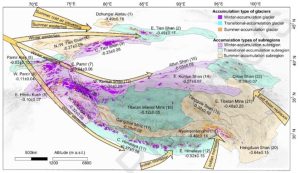
Globally glaciers are rapidly shrinking, endangering the sustainability of melt water and altering the regional hydrology. Understanding long-term glacier response to climate change and the influence of non-climatic attributes like morpho-topographic factors on ice loss is of high relevance. Here we estimate the multi-temporal mass balance of 445 glaciers in the upper Alaknanda basin and neighboring transboundary glaciers using optical stereo imageries from 1973 to 2021. Our measurements indicate a mean annual area change rate of 1.14 ± 0.07 km2 a 1 and a geodetic glacier mass balance of 0.34 ± 0.08 m w.e. a 1 from 1973 to 2020, leading to an overall mass loss of 12.9 ± 1.7 Gt, that accounts for up to 0.036 ± 0.006 mm of sea level rise. Before 2000 (1973–2000), the mean regional glacier mass loss rate was 0.30 ± 0.07 m w.e. a 1, which increased to 0.43 ± 0.06 m w.e. a 1 during 2000–2020. ERA5 Land reanalysis data showed a summer and annual temperature rise of ~0.6 ◦C and ~ 0.5 ◦C respectively in recent time period (2015–2020) and consequent strong mass loss ( 0.68 ± 0.09 m w.e. a 1). In addition to climatic influence, glacier morphometry, topographic features and uneven debris cover distribution further impacted the regional and glacier specific mass balance. Our multi-temporal observation from space also emphasized that though the glaciers in this region experienced an increasing mass loss but a strong heterogeneous glacier specific response, like surging and dynamic separation of glacier, are also evident that was not captured by the available long-term global elevation change grids. Among all the climatic and non-climatic attributes, we identified summer temperature having most significant influence over glacier mass budget in this region, with a mass balance sensitivity of 0.6 m w. e. a 1 ◦C 1. Hence, knowing the mean summer temperature will help to predict the mass balance for any intermediate year for this region. If such climatic trend continues, smaller glaciers are likely to disapear in coming decades. Similar studies in other parts of the world and on specific glaciers can reveal links with climate factors, reconstruct mass balance, and enhance comprehension of glacier response to climate change. Our geodetic mass balance estimates will improve the estimation of meltwater run-off component of the hydrological cycle in this part of the Himalaya, which could be used to calibrate/validate glacier mass balance models.
Reference: Bhattacharya, A., Mukherjee, K., King, O., Karmakar, S., Remya, S. N., Kulkarni, A. V., Kropáček, J., & Bolch, T. (2023). Influence of climate and non-climatic attributes on declining glacier mass budget and surging in Alaknanda Basin and its surroundings. Global and Planetary Change, 230, 104260. https://doi.org/10.1016/j.gloplacha.2023.104260



